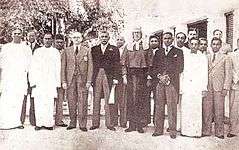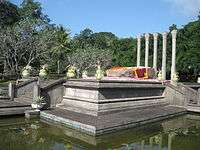S. W. R. D. Bandaranaike
| The Honourable S.W.R.D. Bandaranaike MP | |
|---|---|
.jpg) | |
| Prime Minister of Ceylon | |
|
In office 12 April 1956 – 26 September 1959 | |
| Monarch | Elizabeth II |
| Governor General | Oliver Ernest Goonetilleke |
| Preceded by | John Kotelawala |
| Succeeded by | Wijeyananda Dahanayake |
| Leader of the Opposition | |
|
In office 9 June 1952 – 18 February 1956 | |
| Prime Minister | Dudley Senanayake |
| Preceded by | N. M. Perera |
| Succeeded by | N. M. Perera |
| Chairman of the Sri Lanka Freedom Party | |
|
In office 2 September 1951 – 26 September 1959 | |
| Succeeded by | C. P. de Silva |
| Minister of Health and Local Government | |
|
In office 26 September 1947 – 12 July 1951 | |
| Prime Minister | D. S. Senanayake |
| Preceded by | Position established |
| Succeeded by | Dudley Senanayake |
| Member of the Ceylon Parliament for Attanagalla | |
|
In office 14 October 1947 – 26 September 1959 | |
| Preceded by | Constituency established |
| Succeeded by | James Obeyesekere |
| Personal details | |
| Born |
8 January 1899 Colombo, Ceylon (now Sri Lanka) |
| Died |
26 September 1959 (aged 60) Colombo, Ceylon |
| Political party |
Sri Lanka Freedom Party (1951-1959) United National Party (1946-1951) |
| Spouse(s) | Sirimavo Bandaranaike |
| Relations | Panini Ilangakoon (Cousin) |
| Children |
Sunethra Chandrika Anura |
| Alma mater | Christ Church, Oxford |
| Religion | Theravada Buddhism |
| Website | Official website |
Solomon West Ridgeway Dias Bandaranaike (Sinhalese: සොලමන් වෙස්ට් රිජ්වේ ඩයස් බණ්ඩාරනායක,Tamil: சாலமன் வெஸ்ட் ரிட்ஜ்வே டயஸ் பண்டாரநாயக்கா; 8 January 1899 – 26 September 1959), frequently referred to as S.W.R.D. Bandaranaike, was the fourth Prime Minister of Ceylon (later Sri Lanka) and founder of the left wing and Sinhala nationalist Sri Lanka Freedom Party, serving as Prime Minister from 1956 until his assassination by a Buddhist robe wearer in 1959.[1][2][3]
Early life and education
Bandaranaike was born in Colombo, Ceylon, to an elite Sinhalese Anglican Christian family and was the son of the powerful Sir Solomon Dias Bandaranaike the Maha Mudaliyar (the chief native interpreter and advisor to the Governor) of Horagolla Walauwa in Attanagalla, during British colonial rule, who named his son after West Ridgeway, the Governor of Ceylon at the time and was his god father. In later life he converted to Buddhism in order to join politics.[4] He received his secondary education at S. Thomas' College, Mount Lavinia and went on to study modern greats at Christ Church, Oxford University, where he was Secretary of the famous Oxford Union. He later qualified as a Barrister in England. After having moved there in 1930s. It is also believed he was privately tutuored and was sent to S.Thomas' for sake of records - as it was a requirement to gain admission to a British University one had to be at a formal school. His stint at STC was very brief before he entered Oxford University.
Political career

.jpg)
As a young lawyer Bandaranaike became active in the Ceylon National Congress (CNC). He was elected to the Colombo Municipal Council in 1926. From 1931 to 1947 he served in the State Council of Ceylon. In order to promote Sinhala culture and community interests, Bandaranaike organised the Sinhala Maha Sabha in 1936.[5] In 1946 he backed the United National Party (UNP) and held ministerial posts from 1947 to 1951. In 1951, he led his Sinhala Maha Sabha faction out of the UNP and established the Sri Lanka Freedom Party (SLFP).[6]
On the sensitive issue of language, the party originally espoused the use of both Sinhala and Tamil as national languages, but in the mid-1950s it adopted a "Sinhala only" policy. The party asserts it is a champion of the Buddhist religion, which had been attacked by local Christians and Tamils alike during the colonial era. The SLFP has customarily relied upon the socially and politically influential Buddhist clergy, the sangha, to carry its message to the Sinhala villages. Since the 1950s, SLFP platforms have reflected the earlier organization's emphasis on appealing to the sentiments of the Sinhala masses in rural areas. To this basis has been added the anti-establishment appeal of non-revolutionary socialism.
Bandaranaike became prime minister after winning the 1956 elections in a landslide, at the head of a four-party coalition with a no-contest pact with the Lanka Sama Samaja Party and the Communist Party of Sri Lanka. As such, he made Sinhala the official language of the country, downgrading the official status of English and promoting socialist, non-Western policies that profoundly changed the course of Ceylonese politics in the following decades.
As prime minister, he took a neutralist stance in foreign policy. He removed the British air bases at Katunayake and China Bay and the naval base at Trincomalee. Domestically, he was faced by economic problems and disputes over languages. He is also remembered by the minority Sri Lankan Tamils for his failure to use the state's resources to control the 1958 riots, leading to many deaths of Tamil people at the hands of mobs.
Assassination

In his fourth year in office he died on 26 September 1959, aged 60, at the Merchant's Ward of the Colombo General Hospital due to wounds received after being shot by Talduwe Somarama, a Buddhist monk.
The previous day, 25 September, Somarama had visited Bandaranaike at his private residence, Tintagel, in Rosmead Place, Colombo. Since Somarama appeared to be a member of the Buddhist clergy, he was not searched for weapons and given free access to the prime minister as he began his routine meetings with the public. When the Somarama's presence was intimated to him, Bandaranaike rose to greet him in the traditional Buddhist manner. The assassin then plucked out the revolver hidden in his robes and fired at the prostrate prime minister. The wounded Bandaranaike was rushed to hospital but died the following day despite six hours of surgery by Ceylon's most skilled surgeons.
After Bandaranaike's death, Wijeyananda Dahanayake, minister of education and the leader of the House, took over as caretaker prime minister after being appointed by the Ceylonese parliament. However he fell out of favor with the members of the government, resulting in the removal of all ministers of the Bandaranaike's cabinet in less than a year. Eventually the leadership of the Sri Lanka Freedom Party fell to Bandaranaike's widow Sirima Ratwatte Dias Bandaranaike who was soon appointed a Senator. She became the world's first female Prime Minister when another coalition led by the SLFP won elections in July 1960.
Family life

He married Sirima Ratwatte in 1940 and had three children. Sirima Ratwatte Dias Bandaranaike, as she was known after her marriage, became the first female prime minister in the world following Bandaranaike's assassination. His daughter Chandrika Kumaratunga subsequently became Prime Minister (1994) and the first female Executive president in the country, his younger son Anura Bandaranaike went on to become Speaker of the Parliament of Sri Lanka (2000–2001) and a Minister (2004–08) and his eldest Sunethra Bandaranaike is a prominent philanthropist.
See also
- S. W. R. D. Bandaranaike cabinet
- Bandaranaike-Chelvanayakam Pact
- List of political families in Sri Lanka
References
- ↑ "S.W.R.D.Bandaranaike, or Solomon West Ridgeway Dias Bandaranaike (Prime Minister of Sri Lanka)". Britannica Online.
- ↑ "Bandaranaike, Solomon West Ridgeway Dias". History.Com.
- ↑ "Solomon West Ridgeway Dias Bandaranaike". Encarta.MSN.
- ↑ Nyrop, Richard (1982). Sri Lanka, a Country Study. Supt. of Docs., U.S. G.P.O. p. 197.
- ↑ Richardson, John (2005) Paradise Poisoned: Learning about Conflict, Terrorism, and Development, International Center for Ethnic Studies, Kandy, Sri Lanka, p. 144, ISBN 955-580-094-4
- ↑ Richardson (2005), Paradise Poisoned, p. 145.
External links
| Wikimedia Commons has media related to S. W. R. D. Bandaranaike. |
- The Bandaranaike Museum
- The Bandaranaike Ancestry
- The Ratwatte Ancestry
- Golden Memories of a Political Prodigy
- Commemorating the Bandaranaikes: The Emergence of the Political Middle-Class
- The Pensive Premier
- 49 Years after S.W.R.D. Bandaranaike
- Trail-Blazing Leader
- The Great Son of Sri Lanka
- Website of the Parliament of Sri Lanka
- Sri Lanka Freedom Party's official Website
This page incorporates text from the Library of Congress's Country Studies series.
| Political offices | ||
|---|---|---|
| Preceded by John Kotelawala |
Prime Minister of Ceylon 1956–1959 |
Succeeded by Wijeyananda Dahanayake |
| Preceded by |
Leader of Sri Lanka Freedom Party 1951–1959 |
Succeeded by C. P. de Silva |
